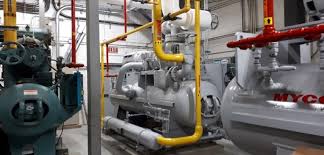Ammonia Refrigeration Installation In A Food Process Plant
Sep 19, 2025
The food processing industry depends on reliable refrigeration systems to maintain product quality, safety, and compliance with strict regulations. Whether it is dairy, meat, beverages, or frozen foods, the ability.
Ammonia Refrigeration Installation in a Food Process Plant
The food processing industry depends on reliable refrigeration systems to maintain product quality, safety, and compliance with strict regulations. Whether it is dairy, meat, beverages, or frozen foods, the ability to control temperature at every stage of processing is critical. Among the various options available, ammonia refrigeration has emerged as one of the most efficient and sustainable solutions for large-scale food plants.
Why Ammonia Refrigeration?
Ammonia has been used as a refrigerant for over a century and remains popular due to its exceptional thermodynamic properties. It offers high energy efficiency, excellent cooling capacity, and is environmentally friendly since it has zero ozone depletion potential (ODP) and zero global warming potential (GWP). For food processing plants that operate continuously, these advantages translate into reduced energy costs and a smaller carbon footprint.
Moreover, ammonia is particularly effective in large industrial systems where conventional refrigerants may struggle to deliver consistent performance. Its reliability makes it a natural choice for facilities that require uninterrupted cooling for raw materials, processing lines, cold storage, and distribution.
Installation Process
The installation of an ammonia refrigeration system in a food process plant begins with detailed planning. Engineers first analyze the plant’s cooling load requirements, taking into account production capacity, product types, and storage needs. Based on this assessment, they design a system that includes compressors, condensers, evaporators, and safety equipment.
During installation, one of the key priorities is safety. Ammonia, while highly efficient, is toxic in concentrated form. Therefore, plant layout must include proper ventilation, leak detection systems, and emergency protocols. Modern installations often integrate automated controls that can detect leaks, shut down affected sections, and alert personnel immediately.
Another important consideration is energy optimization. Advanced ammonia systems use variable speed drives and intelligent control systems to match cooling output with real-time demand. This not only improves efficiency but also extends the life of equipment.
Benefits Realized
After commissioning, the food process plant experiences a number of benefits. The system maintains precise temperature control across production lines, ensuring that products meet strict quality and safety standards. Cold storage areas achieve uniform cooling, reducing the risk of spoilage or inconsistency.
From an economic standpoint, the plant benefits from lower energy consumption compared to systems that use synthetic refrigerants. Ammonia refrigeration also has lower operating costs due to its high efficiency and long equipment lifespan.
Environmentally, the system supports sustainability initiatives, helping the plant align with global trends toward eco-friendly operations. By eliminating harmful refrigerants, the company strengthens its commitment to responsible manufacturing.

